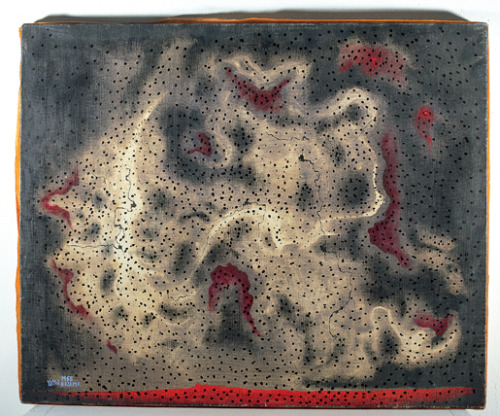Yayoi Kusama has many tags, feminist,
minimalist,
surrealist, abstractist...etc. She is the most famous polka dot lady,
the artistic genius, the woman in the center of the world's attention.
According to record, about 30 percent of designs of Japanese teenager
outfits use polka dots pattern. But in Yayoi Kusama's own description,
she claims herself as merely an "obsessive artist". Yayoi Kusama is widely known for her mental condition, just as much as people know about her polka dots. She suffers from hallucinations and severe obsessive thoughts - what we called the obsessive neurosis, since she was ten. Her
world is often occupied
with illusions, surrounded by what she called "Infinity Nets", a topic
that often appeared in her painting and in her own autobiography. Since
then she puts all her effort into recreating the hallucination she is
seeing. madly repetitive polka dot patterns that represents her world. Yayoi Kusama remained a patient of
a psychiatric hospital in Tokyo and has
continued to live there to this day. Mental illness and art-creation
occupied the majority of her life. In a way, her mental condition has
greatly contributed, inspired, and form the famous artist we know today.
‘One day I was
looking at the red flower patterns of the tablecloth on a table, and when I
looked up I saw the same pattern covering the ceiling, the windows and the
walls, and finally all over the room, my body and the universe. I felt as if I
had begun to self-obliterate, to revolve in the infinity of endless time and
the absoluteness of space, and be reduced to nothingness. As I realized it was
actually happening and not just in my imagination, I was frightened. I knew I
had to run away lest I should be deprived of my life by the spell of the red
flowers. I ran desperately up the stairs. The steps below me began to fall
apart and I fell down the stairs straining my ankle.’ - Yayoi Kusama.

The world is different in her eyes. Yayoi Kusama described her
ongoing series of Infinity Net paintings as, "without beginning, end, or
center. The entire canvas would be occupied by a monochromatic net.
This endless repetition caused a kind of dizzy, empty, hypnotic
feeling." The "nets" are crescent shaped brush strokes of paint across
canvas like flowing river. Each mark is connected, but individually
applied, gradually shifting in directions that's neither random nor
systematic. Compare to other abstract expressions that are more of
bursting energy, her Infinity Net are unpretentious and repetitive,
building a more direct perceptual experience.
 |
| No. 2, Yayoi Kusama |
In 2008, Yayoi Kusama sold her first Infinity Net painting to Donald
Judd for 5,794,500, the highest price paid for a living artist at that
time. The painting is called No.2, done in 1959, the year when she first
initiated the series. The following years she continuous to produce quantitative Infinity Net series, which she would paint
uninterruptedly for 40 to 50 hours.
 |
| Infinity Net TWPPQ |
This is a white on white painting in 2008. Her net has evolved
from her first painting No 2, to a more sophisticated art piece. Like
what she had done with No.2, Yayoi Kusama first painted the canvas black
and layer another layer of white paint on top of the black to create a
constantly shifting space, an indeterminate pictorial depth between the
two colors. Then she adds on repetitive marks of white paint to create
the flowing pattern.
 |
| Inifinity Net TTOOX |
Contrasting to the white on white Infinity Net above, this is a
black on black painting in which Yayoi Kusama obliterates all pictorial
space and utilize the boldness of the color of black paint to its
extent. Although the colors are dark but instead of picking up mostly
darkness from the painting, the viewer sees more light. As the lighting
situation changes in the gallery, the light of the paint shifts as well.
 |
| Infinity Net QZAAL |
Infinity Net QZAAL is a blue on gold painting
done in 2009. The gold seems as if it is floating on top of the surface,
creating a spacial illusion through color.
Her net painting are
recognized as some of the most compelling works of modern art, and she
always return to work on more Infinity Net periodically, as it might be
the purest expression of her sense of art and life. From far distance
these painting almost read as monochromatic, even opaque with noisy
textures. However going up close you will start to see the intricate
patterns among the surface of the canvas; small repetitive marks of
paint which appear to even extend beyond the picture plane to convey
infinity. The viewers will start to wonder, is that really what the
world looks like for Yayoi Kusama?


























